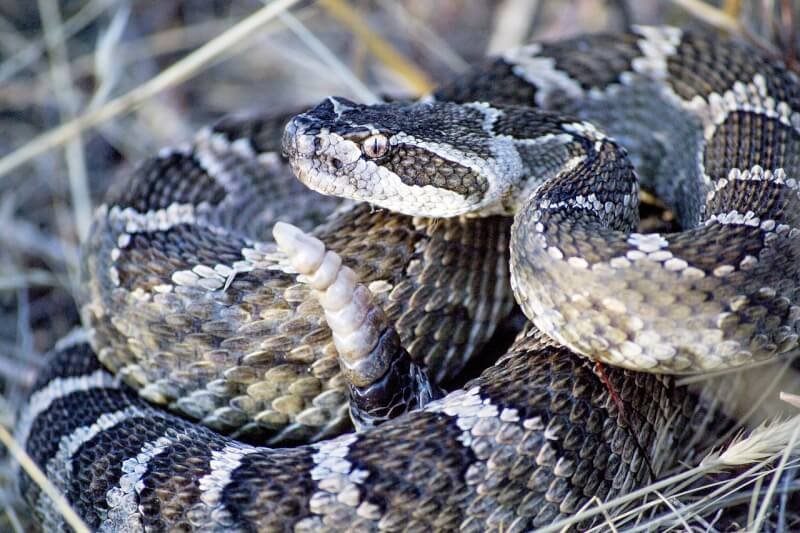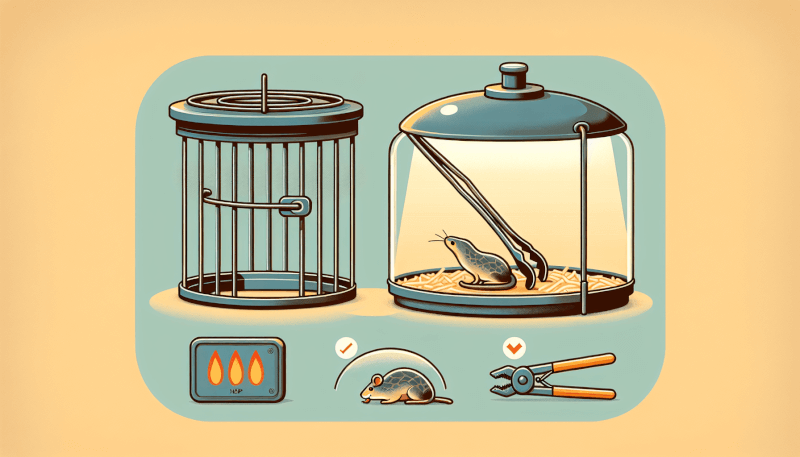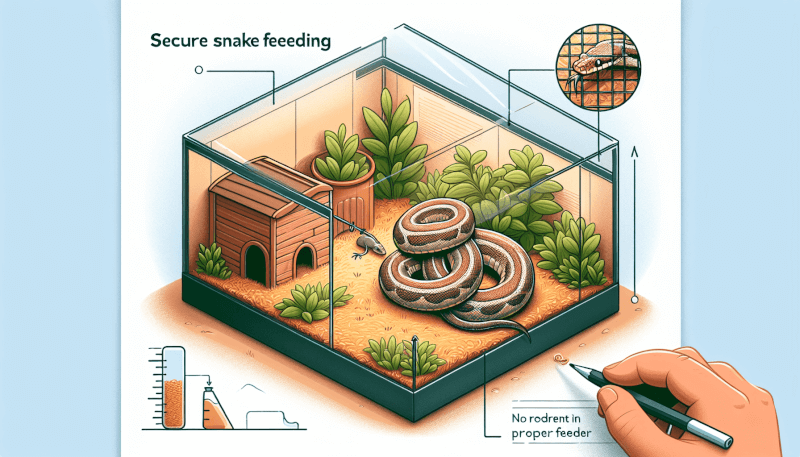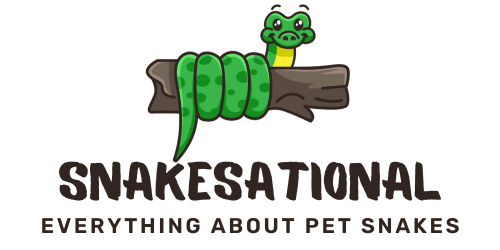If you’re a proud owner of a pet snake, ensuring its safety and well-being is paramount. Creating a secure feeding environment for your slithery friend is crucial to their health and overall happiness. In this article, we will explore some practical tips and guidelines to help you establish the perfect feeding environment for your pet snake. From choosing the right enclosure to managing the feeding process, we’ve got you covered. So, let’s dive into the world of snake care and create a safe haven for your scaly companion.
Choosing the Right Feeding Equipment
Feeding tongs are an essential tool when it comes to feeding your pet snake. To ensure you choose the right size and type of feeding tongs, you should consider the size and species of your snake. Larger snakes may require longer tongs, while smaller snakes may require shorter tongs for better control and precision. Additionally, consider using tongs with blunt tips to prevent any accidental injuries to your snake. Always opt for tongs that are specifically designed for feeding reptiles to ensure the safety and wellbeing of your pet.
Using a Controlled Feeding Container
A controlled feeding container is another important aspect to consider when creating a secure feeding environment for your pet snake. This container will not only help prevent escapes during feeding but also allow for a more controlled feeding session. Be sure to choose a container that is appropriately sized for your snake, providing enough space for them to comfortably eat without feeling cramped. This will help minimize stress during feeding and ensure a safe and contained environment.
Considering Food Safety Measures
In addition to choosing the right feeding equipment and container, it is crucial to take food safety measures into account. Handling prey items with clean and sanitized tools is essential to prevent any potential contamination or transfer of bacteria to your snake. Always wash your hands thoroughly before and after handling prey items, and consider wearing disposable gloves for added hygiene. Additionally, storing frozen prey items at the proper temperature and following thawing instructions carefully is crucial to maintain their nutritional value and ensure the safety of your snake.
Preparing the Feeding Area
Creating a separated feeding space for your snake is an important step to encourage a stress-free feeding environment. This can be achieved by designating a specific area where you consistently feed your snake. By doing so, your snake will associate this space with feeding time, reducing any potential stress or confusion. It is also imperative to remove any potential hazards from the feeding area such as loose objects or hiding spots that could pose a danger to your snake during feeding. Ensuring a quiet and stress-free atmosphere during the feeding session is vital for the snake’s overall well-being.
Removing Potential Hazards
Before every feeding session, take the time to remove any potential hazards from the feeding area. Loose objects or decor that can be knocked over or moved by the snake should be temporarily relocated to prevent any accidental injuries or damage to the enclosure. Additionally, ensure there are no small objects or substances that could be ingested by your snake accidentally. By thoroughly inspecting and removing any potential hazards, you can create a safe and secure feeding environment for your pet snake.
Ensuring a Quiet and Stress-Free Environment
Snakes are sensitive creatures, and a calm and stress-free environment is crucial during feeding time. By minimizing noise and disturbances in the area where you feed your snake, you can help them feel more secure and relaxed. Consider turning off any loud appliances or electronics, and ensure that the feeding area is in a quiet and private location. Avoid sudden movements or loud noises near the feeding area, as these can startle and stress your snake. By providing a peaceful environment, you are creating the ideal conditions for your snake to comfortably eat and digest their meals.

Establishing a Feeding Routine
Determining the Frequency of Feedings Establishing a regular feeding schedule is essential for the overall health and well-being of your snake. The frequency of feedings will depend on the age, size, and species of your snake. Research the specific dietary requirements for your snake species and consult with a reptile veterinarian or breeder for guidance. Generally, snakes are fed once every 1-2 weeks, but some species may require more frequent or less frequent feedings. Finding the right balance is key to ensuring your snake receives the proper nutrition without overfeeding or underfeeding them.
Setting a Schedule
Consistency is key when it comes to feeding your snake, and setting a schedule will help establish a routine. Determine a specific day and time for feeding and stick to it as closely as possible. Snakes often become accustomed to routine, and by feeding them at the same time each week, you can help reduce any potential stress or anxiety associated with feeding time. It is important to note that snakes may refuse food occasionally, especially during shedding or other times of stress. In such cases, it is best to wait until they show interest in eating again, rather than force-feeding or overfeeding.
Monitoring Your Snake’s Appetite
Being attentive to your snake’s appetite is crucial to ensure they are getting the nutrition they need. Pay attention to any changes in their eating habits, such as a sudden decrease or increase in appetite. If your snake consistently refuses food or shows a lack of interest in eating, it may be a sign of an underlying health issue or stress. Consult with a veterinarian who specializes in reptiles to rule out any potential health concerns and ensure your snake’s well-being.
Handling and Positioning the Snake
Using Safe Handling Techniques When it comes to handling your snake during feeding time, it is important to prioritize safety for both yourself and your pet. Use appropriate handling techniques, such as supporting the weight of the snake along its body and avoiding any sudden or jerky movements. It is recommended to handle your snake with the assistance of a snake hook or similar tool to provide an extra layer of control and reduce the risk of accidental bites or injuries. Always be gentle and respectful of your snake’s boundaries to create a positive and stress-free experience for both of you.
Positioning the Snake Correctly
Proper positioning of your snake during feeding ensures they can easily access their prey without any discomfort or obstacles. Position the snake’s head facing the prey item, allowing them to strike and constrict effectively. Depending on the size of your snake, you may need to hold the prey with feeding tongs to ensure it is positioned correctly, as some snakes may require assistance in catching or controlling their prey. By providing the appropriate positioning, you are facilitating a successful feeding session and minimizing any potential stress for your snake.
Avoiding Aggressive Behavior
While snakes are generally docile creatures, it is essential to avoid triggering aggressive behavior during feeding time. Avoid handling your snake immediately before or after a feeding session, as this can make them associate your presence with food and potentially mistake your hand for prey. If your snake displays defensive or aggressive behavior, it is important to give them space and allow them to calm down before attempting to handle or feed them. Creating a calm and stress-free environment during feeding helps maintain a positive relationship with your snake and reduces the likelihood of any aggressive episodes.

Choosing the Proper Food
Identifying the Appropriate Diet for Your Snake Choosing the proper food for your snake is crucial for their health and well-being. Research the specific dietary requirements for your snake species and ensure you are providing a well-balanced diet. Different snake species have varying preferences when it comes to food, with some snakes being strictly carnivorous while others may consume a combination of insects, rodents, or even eggs. It is essential to replicate their natural diet as closely as possible to ensure they receive the necessary nutrients. Consult with a reptile veterinarian or breeder for guidance on the appropriate diet for your snake.
Selecting Prey with Proper Nutritional Value
When selecting prey for your snake, it is important to consider the nutritional value it offers. It is recommended to offer prey that is approximately the same size as the widest part of their body for easier digestion. Additionally, ensure the prey is appropriate for your snake’s size and feeding habits. Consult with a knowledgeable breeder or reptile specialist to determine the appropriate prey size and type for your snake. Providing them with a varied diet that includes different species of prey can help ensure they receive a balanced and nutritious diet.
Dealing with Fussy Eaters
Some snakes can be fussy eaters and may refuse certain types of prey or even go on hunger strikes. This can be particularly concerning for snake owners, as a lack of appetite may indicate an underlying health issue or stress. If your snake consistently refuses food or shows limited interest in certain prey items, you may need to experiment with different types of prey or feeding techniques. Offering live prey, scented prey, or even trying different prey species may help entice fussy eaters. In case of persistent refusal to eat, consult with a reptile veterinarian to rule out any potential health problems and ensure your snake’s well-being.
Feeding in a Controlled Environment
Using a Separate Feeding Enclosure Feeding your snake in a separate enclosure can help establish a controlled environment solely dedicated to feeding. This can help reduce anxiety and minimize any potential distractions for your snake during feeding time. Choose an enclosure that is appropriately sized for your snake, allowing them to comfortably move and eat without feeling confined. It is important to create a suitable environment within the enclosure that mimics their natural habitat, providing hiding spots or proper substrate to aid digestion. By utilizing a separate feeding enclosure, you are creating an optimal feeding environment for your snake.
Creating a Distraction-Free Zone
Feeding your snake in a distraction-free zone is essential to ensure they can focus solely on eating. Place the feeding enclosure in a quiet and secluded area away from excessive foot traffic or loud noises. Consider covering the enclosure with a towel or using opaque dividers to reduce any visual disturbances. Minimize any handling or disturbances during the feeding session, allowing your snake to eat without interruption. By providing a calm and distraction-free environment, you can help your snake feel safe and secure during feeding.
Avoiding Overfeeding
Overfeeding can lead to numerous health issues for your snake, including obesity and digestive problems. It is important to feed your snake appropriately sized prey items that align with their nutritional needs. Avoid the temptation to offer larger prey items or feed more frequently than necessary, as this can lead to overconsumption and potential health complications. Monitoring your snake’s body condition and weight regularly will help you gauge whether you are providing the correct amount of food. Consulting with a reptile veterinarian or breeder can provide valuable insight into the appropriate feeding regimen for your snake.

Monitoring the Feeding Session
Observing the Snake’s Behavior during Feeding While your snake is eating, it is important to closely monitor their behavior for any signs of discomfort or distress. Healthy feeding behavior includes actively striking and constricting their prey, followed by a calm and methodical consumption. If your snake displays any unusual or abnormal behavior, such as repeatedly striking and releasing the prey or seeming unable to consume it properly, it may be a sign of an underlying health issue. Observing their feeding behavior allows you to identify any potential problems and seek veterinary assistance if necessary.
Being Mindful of Indicators of Poor Health
During the feeding session, it is essential to be mindful of any indicators of poor health in your snake. Signs of poor health may include regurgitation of food, weight loss, lethargy, and abnormal bowel movements. If you notice any of these signs, it is crucial to consult with a reptile veterinarian to determine the underlying cause and appropriate course of action. By monitoring the feeding session, you can detect potential health issues early on and provide prompt medical attention to your snake.
Documenting the Snake’s Feeding Patterns
Keeping a record of your snake’s feeding patterns can be beneficial in understanding their dietary needs and detecting any changes in appetite or behavior. Note the date, prey type, prey size, and any observations during the feeding session. This documentation allows you to track their eating habits over time and identify any patterns or irregularities. This information can be invaluable when seeking veterinary advice or adjusting their feeding regimen. By maintaining a feeding log, you can ensure your snake receives the appropriate nutrition and spot any potential health issues promptly.
Cleaning and Sanitization
Cleaning Feeding Tools Regularly Regular cleaning and sanitization of feeding tools are vital to prevent any potential contamination or transfer of bacteria to your snake. After each feeding session, thoroughly wash the feeding tongs with warm water and mild dish soap. Rinse them well and allow them to air dry before storing. It is also recommended to periodically sanitize the feeding tongs using a reptile-safe disinfectant. By practicing proper cleaning and sanitization, you can maintain a hygienic feeding environment for your snake.
Sanitizing the Feeding Area
In addition to cleaning feeding tools, regular sanitization of the feeding area is crucial for maintaining a hygienic environment for your snake. Wipe down any surfaces with a reptile-safe disinfectant to eliminate any bacteria or pathogens. It is important to avoid using harsh chemicals or cleaners that could potentially harm your snake. Allow the area to air dry thoroughly before returning your snake to their enclosure. By incorporating regular sanitization into your cleaning routine, you can minimize the risk of infection or illness for your snake.
Maintaining Proper Hygiene
Maintaining proper hygiene is key to creating a secure feeding environment for your pet snake. Wash your hands thoroughly with warm water and soap before and after handling your snake or any feeding materials. This helps prevent the transfer of bacteria and potential pathogens to your snake. It is also advisable to wear disposable gloves when handling prey items, further reducing the risk of contamination. By practicing good hygiene habits, you are ensuring the health and safety of both yourself and your snake.
Safety Measures for Feeding
Keeping Other Pets Away during Mealtime During feeding time, it is important to keep other pets, such as cats or dogs, away from the feeding area. Other animals may view the snake as potential prey or become overly curious, leading to potential conflicts or injuries. To prevent any accidents or disturbances, ensure the feeding area is securely separated from other pets. Close doors or use barriers to create a safe zone specifically dedicated to feeding your snake. By implementing this safety measure, you can avoid any potential conflicts or harm to both your snake and other pets.
Educating Family Members about Snake Safety
Educating family members or other household members about snake safety is essential to prevent any accidents or mishandling during feeding time. Ensure that everyone understands the importance of not disturbing the snake during feeding, as well as the potential risks associated with mishandling or approaching the snake’s enclosure. Encourage open communication and provide information on safe handling techniques and the importance of maintaining a stress-free environment for the snake. By fostering an understanding and knowledge of snake safety within your household, you are promoting a secure and harmonious feeding environment for your snake.
Creating Barriers to Prevent Escape
Snakes are excellent escape artists, and it is necessary to create barriers to prevent any potential escape during feeding. Ensure that the enclosure is properly secured and that all locks or latches are functioning correctly. Additionally, consider using escape-proof feeding containers to minimize the risk of your snake escaping during a feeding session. Regularly inspect the enclosure for any gaps or openings that your snake could exploit and address them promptly. By creating effective barriers, you can prevent any potential escapes and maintain a secure feeding environment for your snake.
Alternative Feeding Methods
Exploring Frozen/Thawed Prey Options Frozen/thawed prey is a safe and convenient option for feeding your snake. This method involves purchasing frozen prey items that have been previously killed and then thawed before offering them to your snake. This minimizes the risk of injury during feeding and reduces the chances of parasites or diseases being transmitted to your snake. Ensure that the prey items are fully thawed and warmed to room temperature before feeding, as snakes prefer to consume prey that resembles their natural body temperature. Consult with a reputable reptile supplier for a wide variety of frozen/thawed prey options suitable for your snake.
Considering Force-Feeding Techniques if Necessary
Force-feeding should only be considered as a last resort when all other feeding methods have failed. It involves gently and carefully placing food directly into your snake’s mouth to stimulate feeding. Force-feeding should only be done under the guidance and supervision of a reptile veterinarian or an experienced keeper. It is important to note that force-feeding should never be used as a long-term solution and should only be employed under specific circumstances. Always consult with a professional before attempting any force-feeding techniques to ensure the safety and well-being of your snake.
Seeking Professional Advice for Difficult Eaters
If you encounter difficulties with feeding your snake, it is important to seek professional advice from a reptile veterinarian or an experienced snake keeper. They can provide valuable insights and guidance specific to your snake’s needs and circumstances. A professional can help identify any underlying health issues, create a tailored feeding plan, and advise on appropriate handling techniques. Remember, each snake is unique, and there may be specific factors contributing to their feeding difficulties. By seeking professional advice, you can ensure the best care and well-being for your snake.
In conclusion, creating a secure feeding environment for your pet snake requires careful consideration and attention to detail. From choosing the right feeding equipment and establishing a routine to ensuring a stress-free and distraction-free environment, these steps contribute to the overall health and well-being of your snake. By following proper handling techniques, selecting appropriate prey, and practicing good hygiene and safety measures, you can provide your snake with a safe and secure feeding experience. Remember, seeking professional advice when needed is essential to address any feeding challenges and ensure the best care for your snake.


